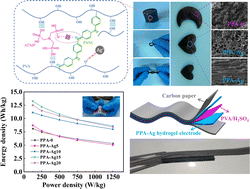High electronic conductivity and excellent specific capacitance still remain challenges for the practical application of hydrogel electrodes. Herein, a novel polymer composite hydrogel electrode, PANI/PVA/ATMP/AgNO3 (PPA-Ag), was successfully constructed through in situ polymerization of aniline (ANI) in a solution of polyvinyl alcohol (PVA), amino trimethylene phosphonic acid (ATMP) and silver nitrate (AgNO3). The incorporation of AgNO3 was expected to enhance the electronic conductivity and specific capacitance of PPA hydrogel electrodes. The AgNO3 incorporated PPA-Ag hydrogel electrodes exhibited a superior specific capacitance (510 F g−1 at 0.5 A g−1), which was much higher than that without AgNO3 incorporation (317 F g−1 at 0.5 A g−1). Additionally, the PPA-Ag hydrogel electrodes also showed excellent flexibility (93.43% capacitance retention after 200 cycles of bending) and excellent cycling stability (81.41% of initial capacitance after 10 000 cycles). The energy storage mechanism originated from the three-dimensional porous structure of the hydrogel, the multiple redox structures of polyaniline, and the Ag+/Ag of silver nitrate. The all-hydrogel-state supercapacitor was assembled based on the PPA-Ag hydrogel electrodes, which delivered a high energy density of 13.3 W h kg−1 at a power density of 125 W kg−1. Meanwhile, the supercapacitors can also maintain above 77% of the initial capacitance after 10 000 charge–discharge cycles. This work constructed polymer hydrogel electrodes with high electronic conductivity and excellent specific capacitance for flexible supercapacitors, which demonstrated great potential within the field of flexible energy storage.
